 |
1844. East Building: famous surviving section toward right (north) of front facade, with tail of one serpent and head of another.
Aquatint, closely based on Catherwood's 1839-42 on-site drawing, published in Catherwood, Views of Ancient Monuments in Central America, Chiapas, and Yucatan, 1844 |
|
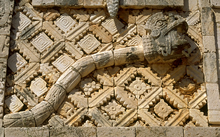 |
Same famous surviving head and adjoing body of serpent, as in print at left.
photo Jan. 2001
|
|
 |
Angled detail showing junction of Serpent's feathered body with undetailed back of head.
photo Jan. 2001
|
|
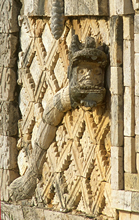 |
Human head, wearing mask, within serpent's open jaws.
photo Jan. 2001.
|
|
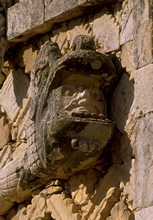 |
Close-up of human head within serpent's open jaws.
photo Jan. 2001.
|
|
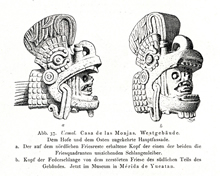 |
1917. "Fig. 37. Uxmal. House of the Nuns. West building. Main facade facing
the courtyard and the east. a. The remaining head on the northern frieze remnants of one of the two serpent bodies surrounding the frieze quadrant. b. Head of the feather serpent from the damaged frieze on the southern section of the building. Now in the Museum in Merida de Yucatan."
Scanned from Eduard Seler, “Die Ruinen von Uxmal,” 1917; closely based on Seler’s on-site drawing (fig.37a, b). |
|
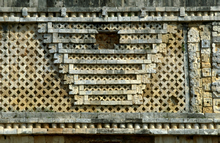 |
East Building, Frieze over 5th doorway from left: trapezoidal tier of double-headed serpents, small central "owl head" missing.
photo Nov. 1999
|
|
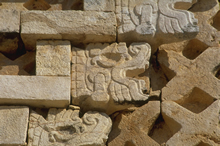 |
Detail of serpent head 3rd from bottom, right side, seen in photo at left.
photo Jan. 2001.
|
|
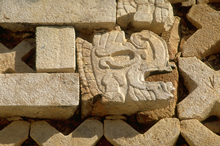 |
Detail of serpent head at bottom-right, seen in photo at far left.
photo Jan. 2001
|
|
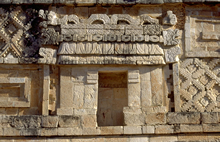 |
North Building, front frieze: Originally, on all sculptures of traditional Yucatec domestic huts, all recessed doorways presumably held sculptured figures.
photo Jan. 2001 |
|
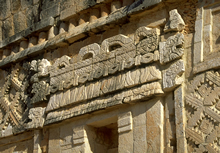 |
Three double-headed serpents; upper one with serpentine body incised with scales, etc.; body of middle serpent composed of open diamonds and ties; body of lower serpent nonexistent, as if hidden behind thatch.
photo Jan. 2001
|
|
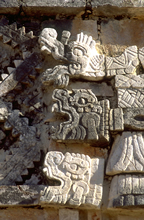 |
3 serpents heads at left of photo at left; carving well preserved.
photo Jan. 2003
|
|